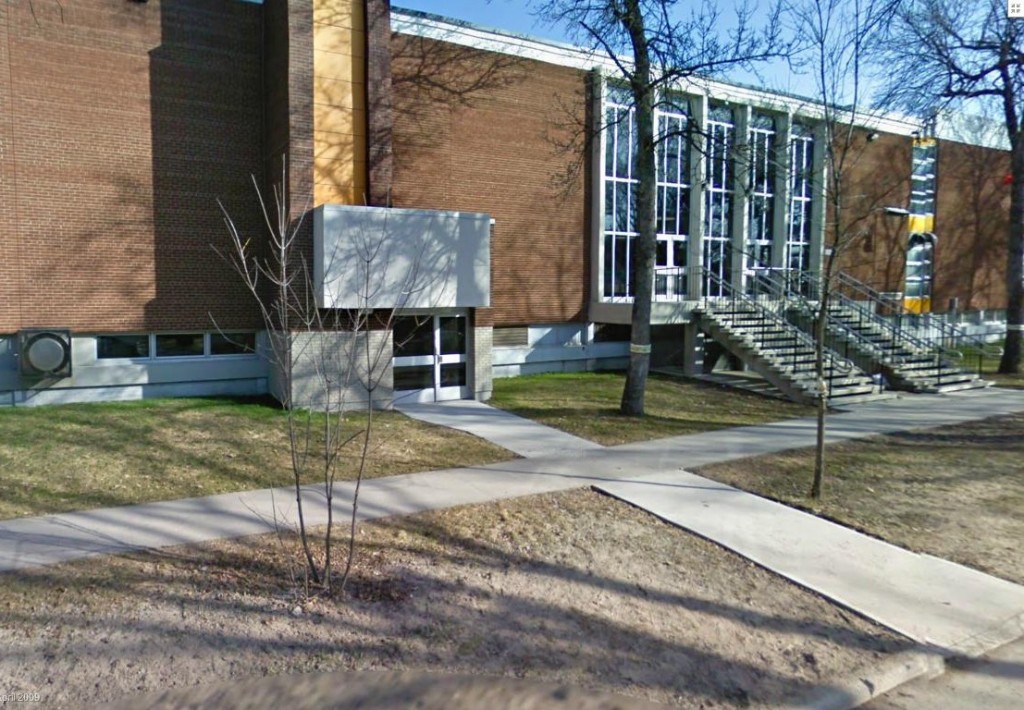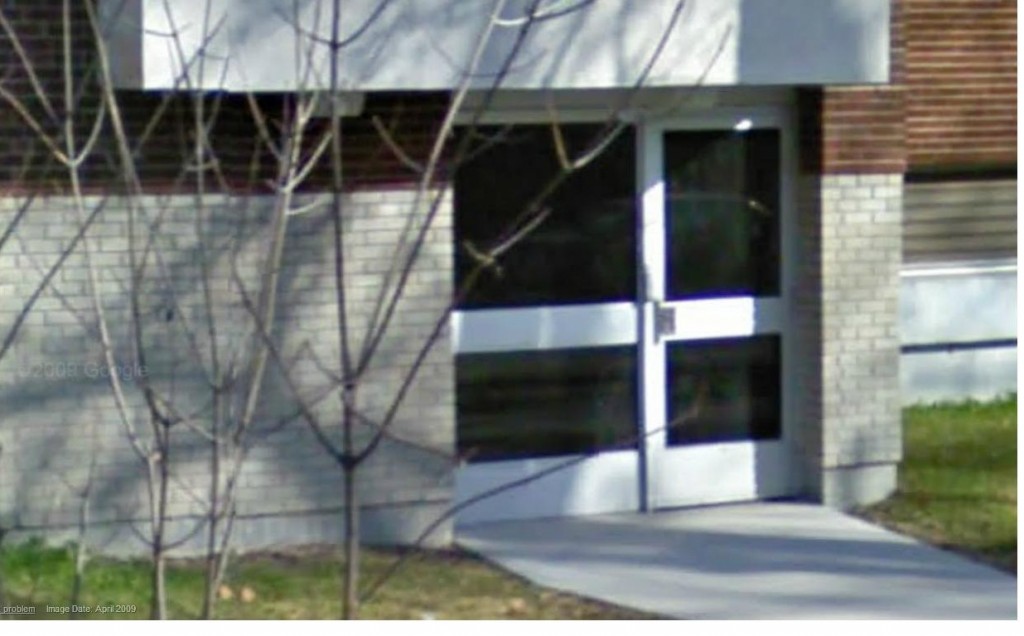When I was attending Kelvin High School for Grade 12*, in Winnipeg, Manitoba, the school did not have an accessible entrance, although they had an elevator with a door at ground level, which opened directly to the outside environment – in other words, you opened the outer door, and to your left is the elevator. (I suppose they avoided being designated as an inaccessible school by calling this piss-poor excuse for an entrance “accessible” because it was technically at ground level, though, as we shall see, it was quite inaccessible.)

The stairs my Mom had to climb every day to get the elevator key are on the right-hand side of this picture. To the left is the locked elevator door.
Once you get through this door, to your right is the keyhole used with a special type of circular key to operate the elevator. That is, assuming you could get in in the first place.
The outer door could not be opened without a willing able-bodied person climbing those stairs (because all disabled people naturally travel and move about with an able-bodied attendant, right? Without them, we might eat the tablecloth while at a restaurant!), going to the principal’s office, and asking for the key, then going back down stairs to give the key to me as I sat in my scooter waiting outside. Every single day, five days a week. Unbelievable.
The administration’s explanation for this nonsense was that if that door were left open, then “random students might be able to get in and misuse the elevator or damage it”. The thing was that the elevator itself could only be operated with yet another key (the round one to which I referred earlier), which the administration would issue to disabled students. Many times during the year, I would ask the administrators why they would not correct this stupid thing. They brushed off my inquiries, and said there was nothing wrong with the current system: nobody else had ever complained. (Try waiting outside for 15-20 minutes every morning when it’s -15 Celsius, you’re sitting down, and you have limited movement in your legs and feet.)
I had enough of this bullshit, and one day I physically took the vice principal by the elbow, dragged her down to the outside entrance, and showed her the error in the school’s logic; it took about 20 minutes of me speaking very slowly and clearly before it penetrated her stegosaurus brain. (In retrospect, I wish I’d done this when it was -15 C, and made her stand outside of that locked door, with no key, for 20 minutes.)
Here’s what that elevator and its ground-level entrance on Kingsway Avenue look like these days (it’s a closeup of the elevator door from the picture above) – the same as they did when I was there in 1999. I’m pretty sure that grey blob by the door is the number combination keypad. OF DOOM! If it isn’t, it may have been removed by the time this Google Maps street view photo was taken because there’s that ground-level accessible entrance OF JOY AND HAPPINESS! on the other side of the building.
It also didn’t seem to occur to the vice principal, or anyone else for that matter, that this situation meant that disabled students who could not climb stairs would be virtually stranded in the event of a fire. During my time at Kelvin High School, there was at least one fire drill; I was in my scooter, on the second floor on my way from Canadian History class to Geography class, and of course the elevators in any building automatically shut down when the fire alarms are activated.
I couldn’t see any fire, feel any heat, or smell any smoke, so I wasn’t worried. I refused to leave the building, parked my scooter near my next classroom, pulled out a book to read, and waited for the drill to be over.
A teacher came along to where I was sitting, and started telling me I needed to get outside. I told them I couldn’t get down the stairs without a mobility aid (this was before the days of Bourne Identity with people launching cars down flights of stairs and mysteriously emerging unscathed), and the elevators were shut down. They insisted that someone would carry me down the stairs and outside, without my scooter, and therefore also without any other mobility aid (when I use my scooter, I do not carry my cane).
My cerebral palsy means I cannot stand unassisted, i.e., without my cane or without leaning against a wall, a chair, a person, etc.
“Oh really? I don’t think so! Fuck off!” (I didn’t actually say this to the teacher, but I made it quite clear that nobody was permitted to carry me anywhere.) What did they expect me to do once we got outside – hang on to someone’s hand or coat lapels or the outside wall of the school? Crouch on the ground on my hands and knees? Because that’s exactly what I would have had to do under those circumstances.
Eventually, after I wrote an English essay on this topic and turned it in, they fitted the outer door with a SUPER-SECRET number-pad combination that I was “never to reveal to any other students”.** The English teacher accused me of complaining, saying the paper had been only a “venting exercise”, but not what he was looking for in a research paper.
Oh really? I did research the building codes and rules regarding disabled access. Here’s an excerpt:
At least one principal entrance in every building within the scope of the new Section is required to have a ‘barrier-free access’. This is a newly defined term that designates a path of travel negotiable by a wheelchair…A barrier-free access is required from the accessible entrance to various specified areas and facilities on the entrance floor, and on every floor served by an elevator if an elevator is provided. The designated areas and facilities to which barrier-free access must be provided are those that serve the public or are designed for use by visitors. [1]
Admittedly, this particular document is a 1985 publication, and it’s not one I used in my paper – that paper with citations I wrote has likely long since vanished into the maw of my mother’s basement – but what I do remember specifically from my research back in 1999 is that buildings in Canada which are older than 50 years are not required to conform to these standards.
On paper, that’s all very well and good – when it comes to heritage buildings, making renovations to make them accessible might be detrimental to the structure of the building which constitutes its status as a heritage site. Winnipeg has many, many buildings and sites rightly designated as “heritage sites” because of their historical significance to the city.
But when it comes to places of primary and secondary education, where you live depends on which school you must attend (catchment area), and there is not a lot of wiggle room. There are “special education schools” for kids that need them, such as the St. Amant Centre; I wasn’t in need of that sort of school, nor did I medically qualify for attendance there.
Kelvin High School was founded in 1912, which means that because it was over 50 years old as of 1999, the administration just might be able to make a case for not being required to update its building code accessibility standards. But we’re not talking about a really old warehouse here. We’re talking about a school. In Making Canadian Schools Inclusive: A Call to Action (2008) by Gordon L. Porter, the author explains what “inclusive education” (also known as “mainstreaming”) means:
Inclusive education means, simply, that all students, including those with disabilities and other special needs, are educated in regular classrooms with their age peers in their community schools. Students with disabilities go to the same schools as their brothers and sisters, are provided with access to the same learning opportunities as other children, and are engaged in both the academic and social activities of the classroom. In inclusive schools, support is directed to both the students and their teachers so they can accomplish relevant individual goals. When this movement started, the word most commonly used was “integration”, but for many, integration implied a less bold vision, limited to the presence of the child in the classroom. Today we understand inclusion to be about how we create environments in which all students can be successful, regardless of ability. [2]
Therefore, how do you access an educational institution that is legally required to include everyone, regardless of physical or intellectual disability, when you cannot even enter the building as easily as everyone else does? Doesn’t that constitute a barrier?
About 10 years later on a visit to Winnipeg where my family still lives, Mom drove us by my old school; it now has a ground level regular entrance. Nobody at the school ever acknowledged what I did.
In this picture (around 2009), the accessible entrance is on the right-hand side of the picture:
One final note: Kelvin High School is also where my mom and dad both graduated from. It was a coincidence of many house-movings that I ended up graduating from there.
* Grade 12 is the final year of Canadian high school (secondary) education, before college or university. Until the school year of 2002-2003, Ontario had an additional “Grade 13”, but since then, it has been phased out.
** In 1999, the number pad combination was 14151. I wonder if it’s still the same today. In any case, should you feel the urge to get in there and use the elevator, without that round key, you won’t be going anywhere. The round key both allows you to open the elevator door itself, and to use the “up” and “down” buttons within. Similarly, you use the round key to call the elevator when you want to use it inside the school.
Helpful Links
Wikipedia: National Building Code of Canada. Retrieved 26 July 2012.
Official Website of the National Building Code of Canada (NBC). Retrieved 26 July 2012.
Canadian Charter of Rights and Freedoms. Retrieved 26 July 2012. Section 15, “Equality Rights,” pertains to people with disabilities. Full versions of the Charter can be found here in both PDF and HTML format.
Bibliography
Hansen, A. T. “Accessibility Requirements in the National Building Code of Canada 1985”. Technical Information Group; Division of Building Research. National Research Council Canada – June, 1985: pp. 1-22. URL: http://www.nrc-cnrc.gc.ca/obj/irc/doc/pubs/bpn/53_e.pdf Retrieved 26 July 2012.
Porter, Gordon L. (2008) “Making Canadian Schools Inclusive: A Call to Action”. Education Canada, Canadian Education Association. Spring 2008. Vol. 48 No. 2. pp. 62-66.
URL: http://www.inclusiveeducation.ca/documents/2MakingCanadianSchoolsInclusiveGPorter.pdf Retrieved 26 July 2012.
Endnotes
[1] Hansen, A. T., p. 2.
[2] Porter, Gordon L., p. 3


